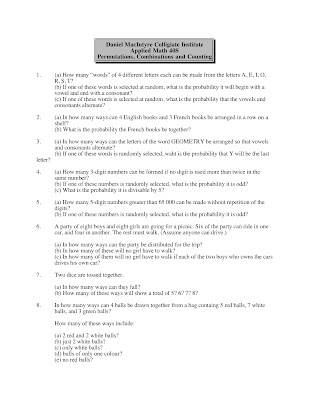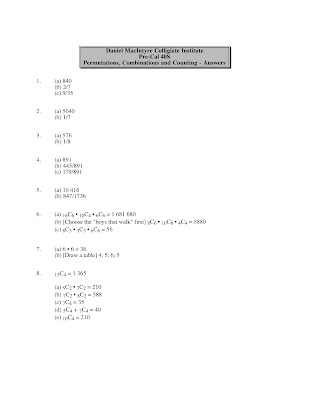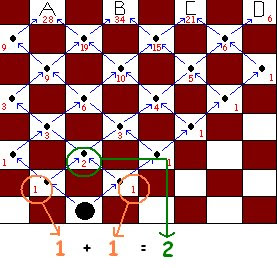The combinations formula is:

n is the number of objects available to be arranged, r is the number of objects that are being arranged.
During our morning class, we started off with this question just as a warm up to what we learned during yesterday's class.
If 8 books are arranged on a shelf, what is the probability that 3 particular books are together.
What we had to find the probability that 3 particular books would be together when we arranged them in different ways.
P(E) = # of favourable outcomes
________Total # of outcomes
The total number of outcomes would be 8! because there are 8 books that are being arranged, that becomes your denominator. Then the number of favourable outcomes would be 6! and 3!. Mr. K started telling us that if we put the 3 particular books that we want to gether in a bag, it would count as 1 book. When we take 3 away from 8 you get 5, but since those 3 books count as one book you add the the 5 and 1, to get the 6! and then 3! would represent the 3 books you want together.
= 6*5*4*3*2*1*3*2*1
The grey numbers: The 6! cancels eachother out.
= 3/28 = 0.1071 or 10.71%
a) How many numbers of 5 different digits each can be formed from the digits 0, 1, 2, 3, 4, 5, 6?
The first 6 because, there are 6 numbers that could possibly become the first number minus 0 because then it would be a 4-digit number instead of a 5-digit number. The second 6 because you cannot repeat numbers, so you lose a number because you've already used one which puts you at 5 but you also gain a number because of the 0 that you haven't used yet. The 5, 4 and 3 are consecutive numbers that follow after losing one more number because of the no repeating number restriction.
b) If one of these numbers is randomly selected, what is the probability it is even?
In the first slot, there can't be a 0 so there would be 6 other possible numbers that could fill in the slot. But then if one of the even numbers were used, then you would only have 5 numbers to choose from but if you used 0 as your last digit then you'd have 6 to choose from again because you gain a digit because you used the 0, which cannot be the first digit.
So, what we did was we split the equation and made it two equations.
Then you take the 1260 and divide it by how many different 5-digit numbers that could be formed. (As done in the part a).
Then like the part b, you put 660 over 2160 to get the probability of the numbers that are divisible by 5.
After doing these questions, we finally started to do questions that had much relation to what we started learning about the "choose formula. We started off with this question:
There are 10 football teams in a certain conference. How many games must be played if each team is to play every other team just once?
Most of us struggled with this question, but after a long agonizing session of figuring out the correct answer or just figuring out an answer Mr. K showed us two ways of doing this question. He showed us how to do it the "long" way by making a chart, of course we decided that it was just too much work and a big waste of time to show a 10x10 chart so we cut it down to a 4x4 chart. We chose to make the teams A, B, C & D.


The first diagram shows how we set up the chart. The second diagram shows us that Team A cannot play their own team, which is shown by the "X" but can play Team B, C and D, which is shown by the check mark. So, so far there has been 3 games played, Team A vs. Teams B, C and D.


The diagram on the far left shows that in the Team A row, there are X's because in column A, it already shows that A has already played Teams B, C and D. The diagram on the right shows that Team B cannot play itself, but can play against Teams C and D and has already played Team A, which is marked with an "X."


The diagram on the far left shows that Team C cannot play itself, but can play Team D and already has played Team A and B. The last diagram shows that Team D cannot play itself and already has played Teams A, B and C. Which completes the table, now we can determine the number of games that were played.
Looking at the last diagram you can determine the number of games played, in column 1 there are 3 check marks, in column 2 there are 2 check marks, in column 3 there is 1 check mark and in column 4 there are no check marks.
That was the "long" way of solving the question. Using a chart is all fun and games, but is there a shorter way of finding the solution to a problem like this? Apparently so. So, here is how we solved this problem in the shortest way possible. This is the equation that we came up with in order to solve the problem.

The sub 10 represents the number of teams and the sub 2 represents the number of teams you need to play a game.
The green numbers: The 10 reduces to 5 because of 2 and 2 becomes a 1.
The grey numbers: The 8! cancels eachother out.
Then we got our final question of the day, which was:
This is the equation that we came up with in order to solve the problem.

The sub 7 represents the number of people and the sub 4 represents the number of people that go one way.




















 The (1) represents the on time colum and the (0) reprsents the late colum.
The (1) represents the on time colum and the (0) reprsents the late colum.







